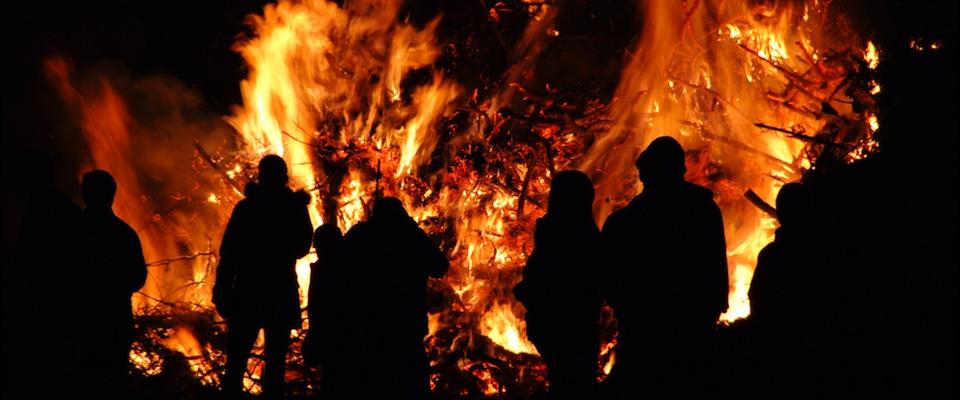If you have the feeling that “wildfire season” is anything but seasonal these days, you’re right. Drought and climate change are combining to make wildfires a year-round phenomenon in the Golden State and much of the West, a trend that already is changing the character of our forests and straining government budgets.
“The fires just keep coming,” observes Scott Stephens, a professor at Cal’s Department of Environmental Science, Policy, and Management and one of the nation’s foremost authorities on wildfire science. “Southern California has had a year-round fire season for a while, but now it appears that’s drifting north. A couple of years ago around Christmas, there was a wildfire on Cobb Mountain [in Lake County], which is usually a very wet area. Change is underway.”
“The forests that our grandchildren’s children inherit are likely to be very different than the ones we have today.”
And in Southern California, says Stephens, that change is both observable and alarmingly rapid.
“I was on Mount Laguna in the Cleveland National Forest [in San Diego, Orange, and Riverside Counties] not long ago, looking at areas where Jeffrey pine had been replanted,” Stephens says. “Jeffrey pine predominated in most of the forests on Mt. Laguna, but the planted areas I was shown had failed completely.”
The U.S. Forest Service managers who were overseeing the project told Stephens that the frequency of the fires on Mt. Laguna and the shifting climate had made the area unsuitable for Jeffrey pine.
“They don’t think they’re going to get the conifers back,” said Stephens. “It was clear to them that the area was shifting to mixed hardwood forests [which can tolerate drier, warmer conditions and greater fire frequency than coniferous forests].”
Indeed, says Stephens, vast portions of California’s coniferous forests, from the Sierra to the coast ranges, are likely to shift to hardwoods and grassy savannas in coming decades.
“Ecotones are changing, and it’s going to have huge impacts on wildlife diversity, carbon sequestration potential, recreation—anything associated with wildlands,” Stephens says. “The forests that our grandchildren’s children inherit are likely to be very different than the ones we have today.”
Contributing to the problem is the way we fight wildfires and fund wildfire fighting, Stephens says, observing that the emphases in wildfire combat have changed in recent years. A few decades ago, fire-fighters could employ landscape-scale strategies to control fires. In some cases, fires could even be allowed to burn, or merely directed instead of expunged. This was especially the case if the fires were meandering and not particularly fierce. Such low-level fires actually improve forests, weeding out thin, diseased, and scraggly trees, eliminating insect pests, and returning nutrients to the soil.
“The problem has been the explosive growth in interface [suburban intrusion into forested areas],” Stephens says. “Now wildfire fighters have to devote much or even most of their time and effort to protecting property. That’s extremely expensive.”
Case in point: A month ago, Stephens was driving through the Sierra foothills near Shingle Springs. “Suddenly, I saw retardant bombers, a spotter plane and a helicopter—but no smoke,” he says. “Then I turned a corner, and I saw this little fire, maybe a half-acre in size. But a lot of people were on it, because there were about a hundred houses within a half-mile. Fire managers had been forced to put all that equipment, all those people, spend all that money, on a tiny fire because of the potential consequences.”
And the shifts in wildfire priorities are crippling wildland management agencies. This year, said Stephens, “… 52 percent of the U.S. Forest Service’s budget will go to fire-fighting. That’s the first time the fire-fighting budget has ever gone over 50 percent. In the early 1990s, it was below 20 percent. And every dollar that is spent on fire-fighting is a dollar that can’t be spent on forest restoration, wildlife and fisheries programs, recreation, and infrastructure. Things have gotten so bad that there’s an effort in Washington to move the largest wildfires—about 2 to 3 percent of the annual total—from the Forest Service budget to FEMA’s budget.”
And yet, things don’t have to be this way. Unlike stemming atmospheric carbon loading, which would demand a global response that would be difficult in the extreme to implement, California’s coniferous forests could be at least partially protected with some basic changes in land use policy. First, says Stephens, the explosive growth in interface must be controlled. That’s a job for the counties and state.
“The counties are allowing, even encouraging, development near or in our forests,” says Stephens. “The more growth we have in interface areas, the worse the problem will be. We have to change that trajectory, and the counties in particular have to play a responsible role.”
Second, people who build houses in the woods should pay for protecting them. As things stand, Stephens observes, the costs of protecting interface areas are borne by taxpayers at large. Somehow, someway, money must be diverted from fire-fighting budgets back to forest management. Because active management of the forests is the only way to get the fire genie back in the bottle. Currently, our forests are as volatile as gasoline because of the poor management policies of the past. Clear-cut logging and replanting has left vast areas stocked with excessive numbers of young closely-spaced trees that are as flammable as tinder. Excessively aggressive fire suppression, particularly in the early to mid-20th century, exacerbated the problem: If every fire is extinguished, the forests become choked with highly flammable deadwood, brush and “doghair” timber.
What is needed, says Stephens, are aggressive thinning and “prescriptive” fire programs. Using chain saws, heavy equipment and low-level fires to thin timber, we would essentially fireproof our wildlands by re-creating the forests of yesteryear, forests that were characterized by large, well-spaced trees that were resistant to catastrophic burning. And in the process, we would be providing jobs for thousands of young people anxious to earn paychecks in the outdoors.
“But we can’t do that if we spend 40 to 70 percent of our forest budgets on fire suppression,” Stephens says. “Unless we get suppression costs in line and start investing in active management, we won’t get ahead of this issue. We have perhaps 30 years to do it before our forests change irrevocably. And it can be done—we know what to do, and how to do it.”



















